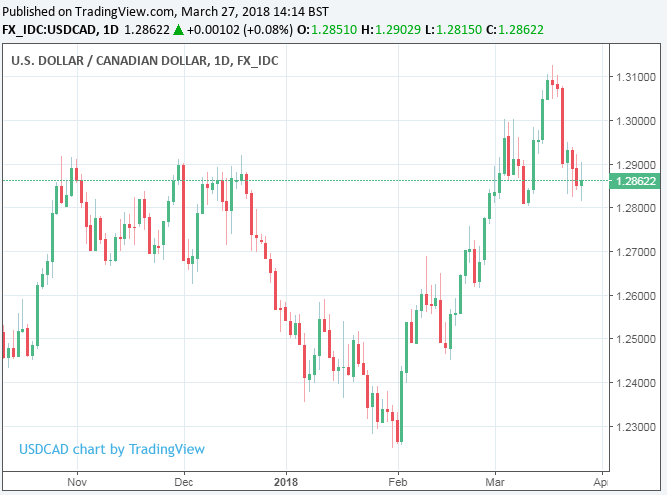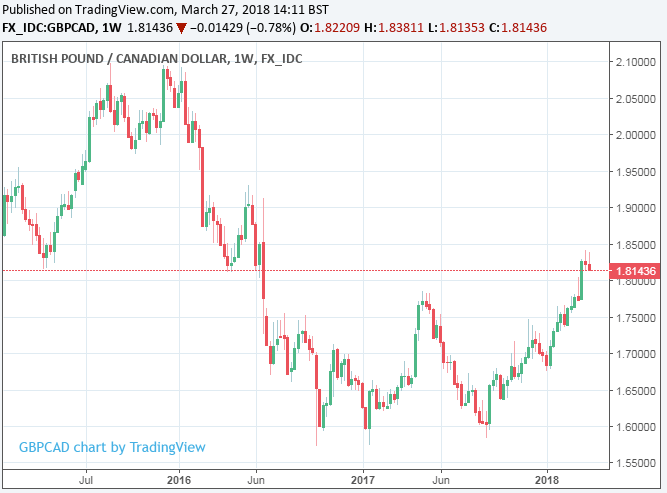Canadian Dollar Could be About to Renew Weakness against US Dollar and Pound: Credit Suisse
- Written by: James Skinner
-
- Canadian Dollar rebounds after inflation rises, trade fears ease.
- Though a souring interest rate outlook to push USDCAD higher still.
- Powerful techinical trends to push Pound-to-Canadian-Dollar rate higher.

© Rawpixel.com, Adobe Stock
The Canadian Dollar arrested its March-long decline during the last week and recoiled against the US greenback and British Pound, although strategists at global investment bank Credit Suisse say there could be renewed weakness lurking just around the corner.
Canada’s unit was previously sent into a tailspin during February and March after Canadian economic data began to soften and the White House stepped up its hostile rhetoric on international trade and, specifically, the North American Free Trade Agreement.
Credit Suisse strategists said at the time that fears over the NAFTA deal could lead traders to become more pessimistic about the prospect of the Bank of Canada meeting market expectations for more interest rate rises in 2018, which would likely weeken the Canadian Dollar and allow USD/CAD to 1.35, its highest level since June 2017.
However, the Loonie has been buoyed higher in recent days by a stronger than expected rise in Canadian inflation for February and an easing of NAFTA fears after the Globe and Mail reported the White House has dropped one of its most contentious demands in talks to renegotiate the pact.

Above: USD/CAD rate shown at daily intervals.
“At the time, we stated that we expected USDCAD to continue trading in a broad 1.20-1.35 range even after the expected break above 1.30. This view remains valid and in the near-term we see a number of catalysts that are likely to keep USDCAD in the upper end of this broad range,” says Alvise Marino, an FX strategist at Credit Suisse, confirming he retains an overall soft stance on CAD.
NAFTA, once described by President Donald Trump as “the worst deal in history”, is being renegotiated under the threat of a US withdrawal. A US withdrawal is the biggest risk to Canada’s economy and currency, with some strategists forecasting a 20% fall in the Loonie if the NAFTA pact is torn up.
“On the surface, several representatives from all three parties have noted an increase in interest in clinching an early deal. At the same time, however, the date of the next round of NAFTA negotiations has yet to be set, and in the meanwhile the US has performed a very notable hawkish shift in trade rhetoric at the global level,” says Marino.
Efforts to renegotiate NAFTA face being stalled until year-end, by campaigning activity for the Mexican Presidential election in July and US midterm elections in November, if a deal cannot be clinched during the April month.
This would leave a material source of uncertainty for the Canadian economy, something the Bank of Canada has flagged on repeated occasions and could therefore see policy-makers hold off on raising interest rates again in the near future.
Markets are looking for another step higher in rates in April; any disappointment could hurt CAD. Meanwhile, a pullback in the average earnings growth numbers seen in the February employment report - from 3.3%yoy to 3.1% yoy - "certainly provided some supportive evidence to the view that the jobs numbers might be underestimating the level of slack in the economy. We see scope for this argument to become more prominent in the BoC’s rhetoric in the coming weeks,” says Marino.
The Bank of Canada raised its interest rate by 25 basis points to 1.25% in January. At the time markets were happy betting the central bank would manage a total of three interest rate rises in 2018 as a whole but since then, interest rate derivatives markets have become less convinced and are now pricing just one more rate rise for 2018.
Marino and the Credit Suisse team flag that there is a risk to even this expectation in the months ahead.
Specifically, they note that the Bank for International Settlements warned there is a risk of a banking crisis in Canada in its latest quarterly report, which the BoC may take as a cue to be more patient about raising interest rates. Particularly in light of high household debt levels in Canada.
“Combined with the other two risks mentioned above, this gives us reason to expect further retracement in BoC tightening expectations – a dynamic that the BoC itself may opt to encourage,” Marino concludes.
GBP/CAD Could be at Cusp of a More Prominent Bull Trend
The uncertainty that is expected to continue driving the USD/CAD rate higher in recent weeks also helped push the Pound-to-Canadian-Dollar rate up to 1.8417 earlier in March, its highest level since the Brexit referendum of June 2016. Credit Suisse also see this exchange rate moving higher during the months ahead, while other strategists have been actively betting on it.
“GBPCAD has rallied strongly to remove the 38.2% retracement of the 2015/16 fall and 2017 high at 1.7724/1.7855 to establish a medium-term base and signal the start of a more prominent bull trend,” says David Sneddon, a managing director of global technical strategy at Credit Suisse. “Resistance is initially seen at the 50% retracement at 1.8345, then the 61.8% retracement at 1.8965. Bigger picture, the “measured base objective” is set significantly higher at 1.9996/2.0000.”

Above: Pound-to-Canadian-Dollar rate shown at weekly intervals.
Advertisement
Get up to 5% more foreign exchange by using a specialist provider to get closer to the real market rate and avoid the gaping spreads charged by your bank when providing currency. Learn more here.









